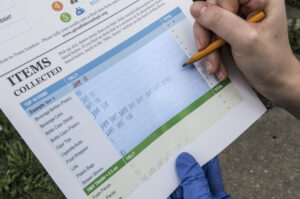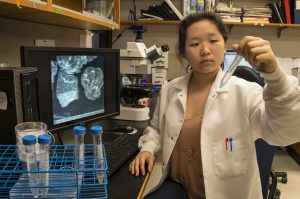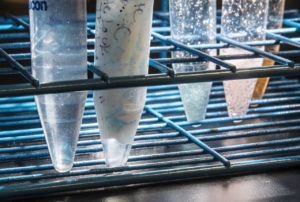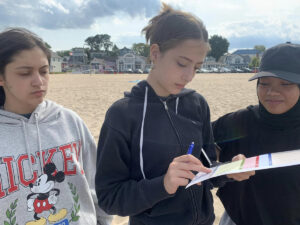Adopt-a-Beach volunteers are on the front lines of keeping litter off our beaches and out of the Great Lakes. But did you know that these volunteers are also citizen scientists?
This year marks twenty years of data collection by Adopt-a- Beach volunteers. The Alliance for the Great Lakes created its online Great Lakes litter database in 2003 and added data collection to the Adopt-a-Beach program.
Filling a Data Gap, Identifying Troubling Trends

While scientists have been studying plastic pollution in the ocean for decades, there is much less research about plastic pollution in the Great Lakes. Adopt-a-Beach data collection is one way our Great Lakes community is beginning to fill that gap. The litter data collected by Adopt-a-Beach volunteers spans beaches and shorelines across all five Great Lakes. No lab or individual researcher could collect this extensive data set on their own. Volunteers have steadily created this dataset with each cleanup over the past twenty years.
Volunteers use a datasheet at every beach cleanup to tally each item they pick up. The event’s team leader tallies up all the data collected at the event and enters it into our online system. Counting each cigarette butt, bottle cap, or piece of tiny trash can sometimes feel a bit silly on the beach. But the power of all that information in one place is impressive, and it is showing us some troubling trends.
So, what do the data tell us? It’s not a pretty picture. Roughly 85% of the litter picked up at cleanups is made entirely or partially of plastic. Most of the litter picked up by volunteers falls into the category of “tiny trash,” which are pieces 5 millimeters or less. These are pieces of larger items that have broken down over time. Food-related trash, such as plastic bottles, plastic cutlery, and takeout containers, is about 25% of the litter picked up by volunteers.
A Clear and Present Danger

While beach litter is a serious concern, it is just the most visible part of a bigger problem. Sun, waves, and other environmental factors break down plastic left on the beach or other places into smaller and smaller pieces. And microfibers from our clothes or plastic packaging from detergent packs wash down the drain into our waterways. These microplastics are often invisible but are dangerous to wildlife, which mistake them for food.
Plastic has been found in Great Lakes fish dating back to the 1950s. That means, for nearly seven decades, there have been microplastics in the lakes, which are a drinking water source for about 40 million people. Today, researchers from the Rochester Institute of Technology estimate that over 22 million pounds of plastic enter the Great Lakes annually. And University of Toronto researchers calculated that the amount of microplastics in the surface water of the Great Lakes is estimated at 1.2 million particles/km2. This is higher than plastic concentrations in the widely publicized Great Pacific Garbage Patch.
Microplastics have been found in drinking water, bottled water, and beer. And it’s estimated that we each ingest about a credit card-sized amount of plastic each week. Much remains to be learned about the impacts of plastic on human health, but the early picture is concerning.
Plastic Producers Must Take Responsibility

Adopt-a-Beach volunteers do a great job keeping plastic out of our lakes and educating their communities about the plastic pollution problem. But beach cleanups alone can’t solve the magnitude of the Great Lakes’ plastic problem. A more systemic solution is required.
Currently, most efforts to stop plastic pollution put the responsibility on the last person who uses the plastic, such as recycling. But expecting end users to bear the burden of managing plastic pollution isn’t effective. For instance, only a fraction of plastic produced each year can be recycled, leaving the remainder to end up in landfills or as litter that lands in our waterways. This leaves the disposal burden – and significant costs – on individuals, small business owners, and local governments.
The alternative is to require plastic producers to be responsible for their products through their lifecycle, called extended producer responsibility. The concept is not new. Many European countries have such laws. And California recently passed legislation bringing the concept to the United States. These laws reduce or eliminate the most problematic plastics like styrofoam, require plastic manufacturers to pay for disposal, or eventually change their practices to produce less plastic in the first place.
For the first time, we have included plastic pollution as a top issue in our federal Great Lakes policy agenda. We are urging Congress to be a leader in curbing plastic pollution and pass legislation that:
- Makes plastic producers responsible for reduction of waste
- Reduces the federal government’s use of single-use plastics
- Funds additional research on the public health impact of plastics
How You Can Help

Solving our Great Lakes plastic pollution problem will take all of us. Here are several ways you can help:
Refuse single-use plastics.
The best way to prevent plastic pollution from getting into the lakes is to stop using it in the first place.
Your voice makes a difference.
Visit our action center to send a letter to your members of Congress, urging them to adopt extended producer responsibility legislation.
Join a beach cleanup.
Adopt-a-Beach volunteers are on the frontlines of keeping plastic pollution out of the Great Lakes. It’s fun, easy, and an excellent way for your family, community group, or business to give back to the lakes. Learn how you can join a cleanup or host one of your own.
